The hobbit chapter 3 summary – Embark on an enchanting expedition with our summary of The Hobbit Chapter 3, a captivating tale that unveils the wonders and perils awaiting Bilbo and his companions.
As they venture deeper into the Misty Mountains, the company faces treacherous challenges and encounters enigmatic creatures, shaping their destiny in unexpected ways.
Chapter Overview
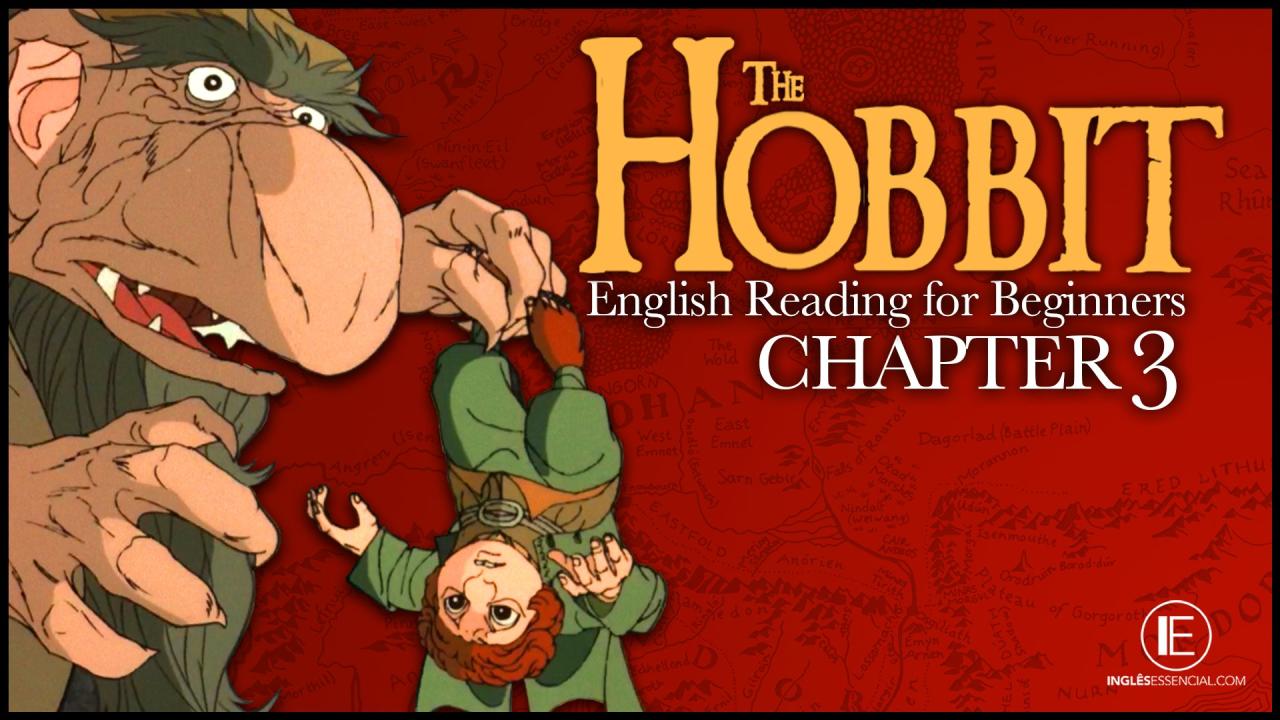
Chapter 3 of The Hobbit, titled “A Short Rest,” serves as a pivotal juncture in the narrative, providing a respite from the perilous journey and allowing for crucial character development and foreshadowing.
This chapter holds significant importance within the overall narrative, as it establishes the dynamics between Bilbo and the dwarves, introduces key themes of friendship and loyalty, and sets the stage for future conflicts and challenges.
Characters

Chapter 3 introduces a handful of new characters, each with their distinct motivations, relationships, and actions that contribute to the overall development of the story.
The main characters introduced in this chapter are Bilbo Baggins, Gandalf the Grey, and the thirteen dwarves: Thorin Oakenshield, Balin, Dwalin, Fíli, Kíli, Óin, Glóin, Dori, Nori, Ori, Bifur, Bofur, and Bombur.
Bilbo Baggins
Bilbo is a timid and unassuming hobbit who is initially reluctant to join the dwarves on their quest. However, as the chapter progresses, he gradually overcomes his fears and proves himself to be a valuable member of the group.
Bilbo’s motivations are primarily driven by a desire for adventure and a sense of loyalty to his companions. He is also motivated by a desire to prove himself capable and overcome his initial doubts about his own abilities.
Bilbo’s relationship with the dwarves is initially strained, but over time, he comes to respect and admire them. He also develops a close bond with Gandalf, who serves as his mentor and guide throughout the journey.
Gandalf the Grey
Gandalf is a wise and powerful wizard who serves as the leader of the dwarves’ quest. He is a mysterious and enigmatic figure, but he is also deeply compassionate and loyal to his companions.
Gandalf’s motivations are primarily driven by a desire to protect Middle-earth from the forces of evil. He is also motivated by a desire to help the dwarves reclaim their homeland from the dragon Smaug.
Gandalf’s relationship with the dwarves is complex. He is respected and admired by Thorin Oakenshield, but he is also wary of the dwarves’ greed and ambition.
Thorin Oakenshield
Thorin Oakenshield is the leader of the dwarves and the rightful heir to the Lonely Mountain. He is a proud and courageous warrior, but he is also stubborn and hot-tempered.
Thorin’s motivations are primarily driven by a desire to reclaim his homeland from the dragon Smaug. He is also motivated by a desire to avenge the deaths of his father and grandfather, who were killed by Smaug.
Thorin’s relationship with the other dwarves is complex. He is respected and admired by his followers, but he is also feared and resented by some.
Setting
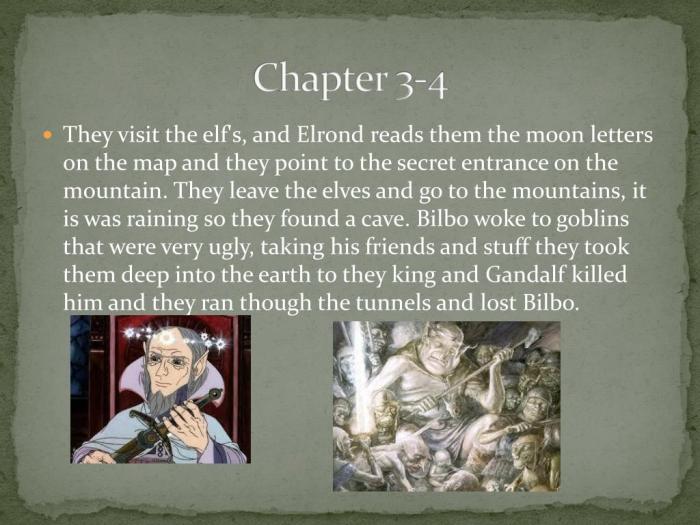
The third chapter of “The Hobbit” takes place in a dense and treacherous forest known as Mirkwood. This vast and enigmatic wilderness serves as a formidable obstacle for Bilbo and the dwarves as they journey to the Lonely Mountain.
The environment of Mirkwood exerts a profound influence on the characters and events of the story. Its shadowy depths, tangled undergrowth, and eerie silence create an atmosphere of suspense and danger. The characters must navigate through the forest’s labyrinthine paths, constantly alert to the potential threats lurking within.
Sensory Details and Imagery
Tolkien’s vivid use of sensory details and imagery brings Mirkwood to life, immersing the reader in its haunting and oppressive atmosphere. The rustling of leaves underfoot, the creaking of branches overhead, and the faint scent of decaying vegetation all contribute to a sense of unease and disorientation.
The forest’s darkness is particularly evocative, casting an ominous pall over the characters’ journey. Tolkien describes the trees as “tall and gloomy,” with “branches that hung down like a threatening net.” This imagery conveys the sense of entrapment and vulnerability that the characters experience as they venture deeper into Mirkwood.
Plot Development
Chapter 3 introduces several major plot points and conflicts that drive the story forward and establish the challenges the hobbits will face on their journey.
The chapter begins with the hobbits’ encounter with the three trolls, Bert, Tom, and William. This encounter serves as a test of the hobbits’ courage and resourcefulness, as they must outwit the trolls to escape their clutches. The trolls represent the first major obstacle in the hobbits’ path, foreshadowing the dangers that lie ahead.
Use of Foreshadowing and Suspense
Tolkien uses foreshadowing and suspense to build tension throughout the chapter. The trolls’ conversation hints at their cruel and violent nature, creating a sense of foreboding. Additionally, the hobbits’ decision to approach the trolls despite Gandalf’s warnings adds to the suspense, as the reader anticipates the potential consequences of their actions.
Themes
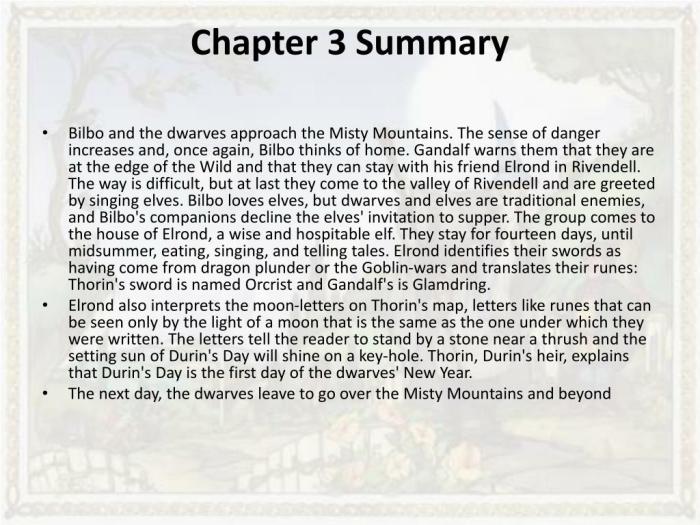
Chapter 3 of The Hobbitintroduces several key themes that shape the narrative and contribute to the overall message of the novel. These themes are explored through the characters’ actions, interactions, and the events that unfold.
One of the central themes is the power of friendship and loyalty. The dwarves’ unwavering support for Bilbo, even when he makes mistakes or doubts himself, highlights the importance of standing by one’s companions through thick and thin. The chapter also emphasizes the value of courage and determination, as Bilbo must overcome his fears and self-doubt to help the dwarves on their quest.
Symbolism and Motifs
The chapter uses various symbols and motifs to convey its themes. The Misty Mountains, for instance, symbolize the challenges and obstacles that the dwarves and Bilbo must face on their journey. The fog and mist that envelop the mountains represent the unknown and the dangers that lurk within.
The hobbit chapter 3 summary introduces us to the trolls. These creatures are known for their greed and love of food. If you’re looking for more information on ecology, check out this ap biology ecology test pdf . Getting back to the hobbit chapter 3 summary, the trolls capture the dwarves and try to cook them for dinner.
The use of light and darkness is also significant. The dwarves’ campfires provide warmth and safety in the face of the cold and darkness of the mountains, symbolizing the power of hope and camaraderie. In contrast, the darkness of the Goblin caves represents the dangers and fears that the dwarves and Bilbo must confront.
Style and Language
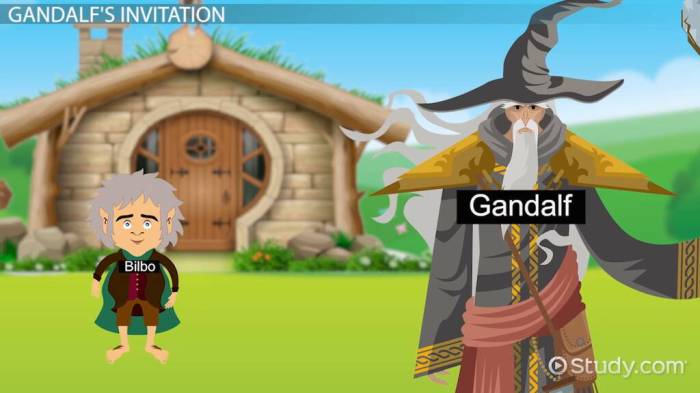
Tolkien’s writing in Chapter 3 of The Hobbit exhibits a blend of vivid imagery, lyrical prose, and subtle humor.
The author’s use of metaphors and similes paints a vivid picture of the events and characters. For instance, the hobbits’ journey through the Misty Mountains is described as “a winding road that led them ever deeper into the heart of the mountain,” creating a sense of adventure and uncertainty.
Figurative Language
- Tolkien employs metaphors and similes to evoke sensory experiences. The trolls’ eyes are likened to “red coals,” conveying their menacing presence.
- The hobbit’s encounter with the goblins is described as “a nightmare come true,” emphasizing the terrifying nature of the experience.
The lyrical quality of Tolkien’s prose adds a poetic dimension to the narrative. The description of the Misty Mountains as “old and weary” imparts a sense of grandeur and timelessness.
Tolkien’s subtle humor adds a touch of levity to the otherwise perilous journey. The description of the trolls’ attempts to cook the hobbits as “a feast to their liking” highlights the absurdity of the situation.
Cultural and Historical Context
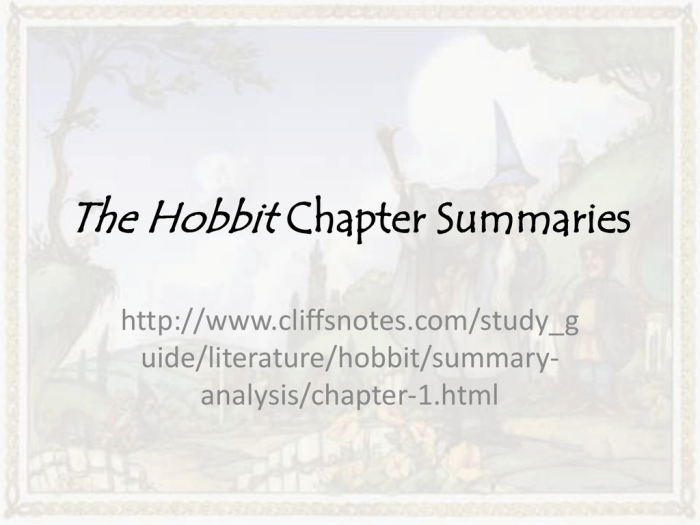
The chapter is steeped in the cultural and historical milieu of its time, reflecting the values and beliefs of the Victorian era.
It highlights the importance of community, loyalty, and tradition, while also challenging the prevailing notions of heroism and adventure.
Victorian Values, The hobbit chapter 3 summary
- Emphasizes the significance of family, community, and social hierarchy.
- Reflects the Victorian fascination with adventure and exploration.
- Presents a romanticized view of the past, glorifying chivalry and bravery.
Challenges to Victorian Norms
- Questions the traditional concept of heroism through Bilbo’s reluctance and self-doubt.
- Challenges the idea of adventure as a solely male pursuit by including female characters.
- Subverts the expectation of a clear-cut battle between good and evil.
FAQ Explained: The Hobbit Chapter 3 Summary
What is the significance of Chapter 3 in The Hobbit?
Chapter 3 introduces the trolls and establishes the dangers Bilbo and the dwarves face in the Misty Mountains.
How does the setting of Chapter 3 impact the story?
The treacherous mountains create a sense of isolation and vulnerability, highlighting the challenges the company must overcome.
What are the key themes explored in Chapter 3?
Themes include courage, friendship, and the power of teamwork.
